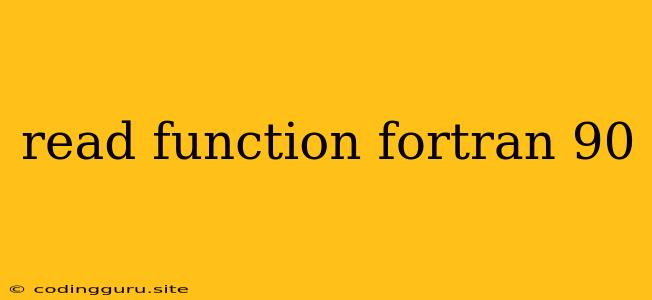Understanding and Using the READ Function in Fortran 90
Fortran 90, a powerful and versatile programming language, provides various tools for interacting with data. One of the most fundamental tasks is reading data into your program, and the READ function plays a crucial role in this process.
This article will explore how to effectively use the READ function in Fortran 90 to get your data flowing into your programs.
What is the READ Function in Fortran 90?
The READ statement in Fortran 90 allows your program to receive input data from various sources. Think of it as a gateway that brings data from the outside world into your program's internal storage.
Why Use the READ Function?
You might need to use the READ function in several situations:
- Reading data from a file: This is often the most common use case. Imagine your program needs to analyze data stored in a text file, perhaps a list of measurements, customer information, or scientific observations. The READ statement lets you access this data.
- Getting input from the user: Want to make your program interactive? The READ function can receive input directly from the user through the keyboard. This enables your programs to respond to user prompts and perform calculations based on their input.
- Reading data from external devices: While less common, the READ function can also be used to access data from other sources like network connections or specific hardware devices.
How the READ Function Works
The READ function has a specific format. It involves specifying the source of the data, the variables to store the data, and any formatting instructions.
Here's a basic structure:
READ (unit=unit_number, fmt=format_specifier) variable1, variable2, ...
Explanation:
- unit=unit_number: Identifies the source of the data. This is typically an integer representing a file unit number. For example,
unit=5refers to the standard input (usually the keyboard). - fmt=format_specifier: Specifies the format of the data to be read. This can be a format string (e.g.,
fmt="(I5, F10.2)") or a pre-defined format label. - variable1, variable2,...: The list of variables where the data will be stored.
Examples of READ Function Usage
Let's illustrate with some practical examples:
1. Reading Data from a File:
PROGRAM read_data
IMPLICIT NONE
INTEGER :: i, unit_number = 10
REAL :: temperature
CHARACTER(LEN=20) :: filename
filename = 'temperature_data.txt'
OPEN(UNIT=unit_number, FILE=filename, STATUS='OLD', ACTION='READ')
DO i = 1, 10
READ (unit=unit_number, fmt=*) temperature
WRITE (*, *) 'Temperature:', temperature
END DO
CLOSE (unit=unit_number)
END PROGRAM read_data
This example opens a file named "temperature_data.txt" and reads the temperature values from it, displaying them on the screen.
2. Getting User Input:
PROGRAM user_input
IMPLICIT NONE
INTEGER :: age
REAL :: height
WRITE (*, *) 'Enter your age:'
READ (*, *) age
WRITE (*, *) 'Enter your height (in meters):'
READ (*, *) height
WRITE (*, *) 'Your age is:', age
WRITE (*, *) 'Your height is:', height
END PROGRAM user_input
This program prompts the user to enter their age and height, storing these values in variables age and height before displaying them back.
Common Issues and Troubleshooting
While the READ function is generally straightforward, you might encounter some problems:
- Incorrect file path or filename: Double-check your filename and ensure it is correct and that the file exists in the expected location.
- Missing or invalid input: If you're reading from the user, ensure they provide the correct data type and format as expected.
- Format mismatch: Be sure your format specifier in the READ statement matches the data in your file or user input.
- End-of-file conditions: Handle the scenario where the file reaches its end, preventing errors.
Conclusion
The READ function is an essential tool for bringing data into your Fortran 90 programs. Whether you are working with files, user input, or other external data sources, understanding how to utilize the READ function effectively will allow you to develop powerful and versatile programs.
Remember to carefully consider the data source, format, and error handling to ensure robust and reliable data processing in your applications.
